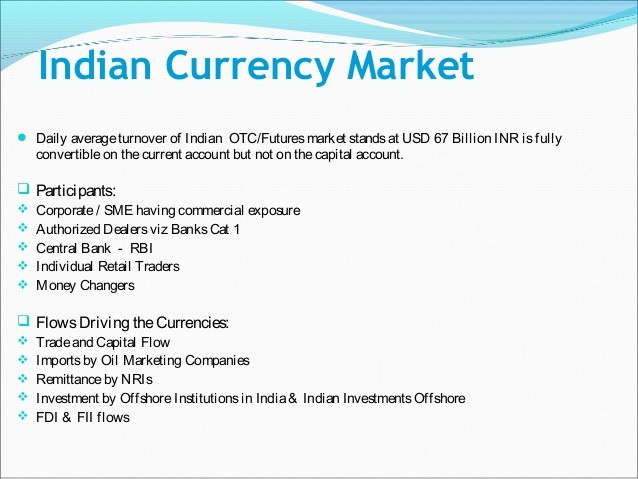Hedging Exposure to the Indian Rupee
Post on: 26 Май, 2015 No Comment

Should Investors Hedge Exposure to the Indian Rupee?
by Jeremy Schwartz. Director of Research and Rick Harper. Head of Fixed Income & Currency on April 2, 2014
In our last blog post on the performance of Indian equities, we showed them reaching all-time highs. 1 This fact may surprise U.S. investors, as certain indexes of India’s equities are down over 30% cumulatively since 2007, a result of the Indian rupee’s decline by approximately 36% over the same period. 2
Now seems like a perfect time to use currency-hedged strategies in India as protection against these declines in the rupee. But the currency-hedging story in India is not as straightforward as it is in Europe or Japan today. Why? It would be too expensive to hedge the Indian rupee now, with the cost eroding the protection from loss in the currency’s value against the U.S. dollar.
Developed Market Currency Hedging Is Different Than Currency Hedging in India
One reason we advocate currency hedging in Europe and Japan is because it is relatively inexpensive to hedge. The primary cost of currency hedging is based on short-term interest rate differentials between the foreign market and the home market. The difference between Japanese or European interest rates and U.S. interest rates is currently so low that hedging their currencies is essentially a free option for U.S. investors. At some point, if short-term interest rates in the U.S. normalize and become higher than those similar interest rates in Japan or Europe, one might actually get paid the higher interest rate differential to hedge the yen or the euro.
But in India the situation is very different. Interest rates are high, making the cost to hedge the rupee high for U.S. investors. The sizable short-term interest rate differential between India and the U.S. represents a “hurdle rate ” for how much the rupee has to depreciate before U.S. investors can break even on the cost of that hedge. Given these high hurdle rates we think it’s difficult to make a case that the hedge adds long-term value, specifically given the extraordinarily low U.S. short-term interest rates. Right now, the spread between implied yields for 1-month rupee forwards and 1-month London Interbank Bid (LIBID) rates is 7.53%. 3 Consequently, in neutralizing rupee exposure, investors face a 7%-plus annual headwind or—in other words—can expect to lose about 65 basis points a month. If one is convinced the rupee could depreciate more than that over the investment horizon, then it would make sense to hedge.
Our Strategic Approach to India’s Currency
We would argue that strategic investors would rather be on the opposite end of that trade, with the potential to collect the higher interest rate in India’s local markets. That is why we created the WisdomTree Indian Rupee Strategy Fund (ICN). which benefits from high short-term interest rates available to investors in India.
This Fund takes the opposite side in the same instruments—non-deliverable forward contracts —to collect the interest rate premium. instead of paying it, as one would need to do to hedge the exposure. The forward contracts in the Fund are also collateralized by U.S. cash investments. The combination of interest from the U.S. cash instruments with the interest rate premium approximates the local money market rates in India, which is how the strategy seeks to accomplish its objective.
The differential in the exchange rate performance of the rupee and the return of this Fund over its life provides a simple estimate for how much it would have cost to hedge the rupee over nearly five years of live performance history.
Illustrating the Impact of India’s Higher Short-Term Interest Rate
For definitions of terms in the chart, please visit our Glossary .
Average Annual Returns (as of December 31, 2013)
The Case for the Rupee: Currently at a Significant Discount
On a long-term basis, the Indian rupee is an emerging market currency selling at the greatest discount to purchasing power parity of all emerging market currencies. Some of this discount is warranted—the high inflation levels in India will likely be a headwind for the currency, as it erodes India’s purchasing power over time. But the convergence of India’s demographics and income growth potential with those of the rest of the world argues the long-term fundamental case for the country’s ability to catch up as money flows into its economy.
India’s Central Bank Establishing Credibility
There is no question India’s currency has been volatile. But the new head of its central bank, Raghuram Rajan, has been a very positive influence. By hiking interest rates during his early days in office, he made it more expensive for speculators and hedgers to short the rupee. He also re-established the inflation-fighting credibility of the central bank in the eyes of many investors. This has made it more attractive to get exposure to the rupee via a fund, such as ICN, that seeks to collect the interest rate differential after expenses.
Macroeconomic Tide May Be Turning
Additionally, India has been proactive in addressing its external vulnerabilities and fiscal corruption concerns. Its current account position has improved considerably, inflation has slowed— even though it remains high, specifically for core consumer prices —and slow but encouraging progress on fiscal reforms has been made.
There is also an emerging consensus that the opposing Bharatiya Janata Party (BJP) and its coalition for the upcoming national elections will have the potential to provide a boost for investor confidence in India.
From a valuation standpoint, long positions in the rupee against the dollar offer a high level of carry or potential interest return per unit of risk. The rupee ranks third in its measure of carry to its volatility amongst other emerging market currencies, behind the Peruvian new sol and the Brazilian real. 4

Conclusion: Portfolio Perspective on the Rupee
If one is looking to get access to emerging markets, the high interest rates in India are an interesting way to achieve that exposure. We think allocations to ICN have broad applications within client portfolios, such as:
1) Augmenting emerging market fixed income portfolios: For many investors, assessing the pros and cons of exposure to rupee debt can be challenging; ICN can facilitate access to the Indian currency and its local short-term rates.
2) Blending in with Indian equities to help mitigate the risk profile of one’s overall Indian investments.
1 Refers to the S&P BSE SENSEX Index hitting 21,934 as of 3/10/2014.
2 Refers to the WisdomTree India Earnings Index and the Indian rupee’s cumulative returns from 12/3/2007 to 2/28/2014.
3 Source: Bloomberg, as of 2/26/2014, effectively the last day of the month with viable data.
4 Source: Bloomberg, as of 02/28/2014.
Important Risks Related to this Article
There are risks associated with investing, including possible loss of principal. Foreign investing involves special risks, such as risk of loss from currency fluctuation or political or economic uncertainty. This Fund focuses its investments in India, thereby increasing the impact of events and developments associated with the region, which can adversely affect performance. Investments in emerging or frontier markets are generally less liquid and less efficient than investments in developed markets and are subject to additional risks, such as risks of adverse governmental regulation and intervention or political developments.
Investments in currency involve additional special risks, such as credit risk and interest rate fluctuations. Derivative investments can be volatile, and these investments may be less liquid than other securities, and more sensitive to the effect of varied economic conditions. As this Fund can have a high concentration in some issuers, the Fund can be adversely impacted by changes affecting those issuers. Unlike typical exchange-traded funds, there are no indexes that the Fund attempts to track or replicate. Thus, the ability of the Fund to achieve its objectives will depend on the effectiveness of the portfolio manager. Due to the investment strategy of this Fund, it may make higher capital gain distributions than other ETFs. Please read the Fund’s prospectus for specific details regarding the Fund’s risk profile.
Investments focused in Europe and Japan may increase the impact of events and developments associated with those regions, which can adversely affect performance.














